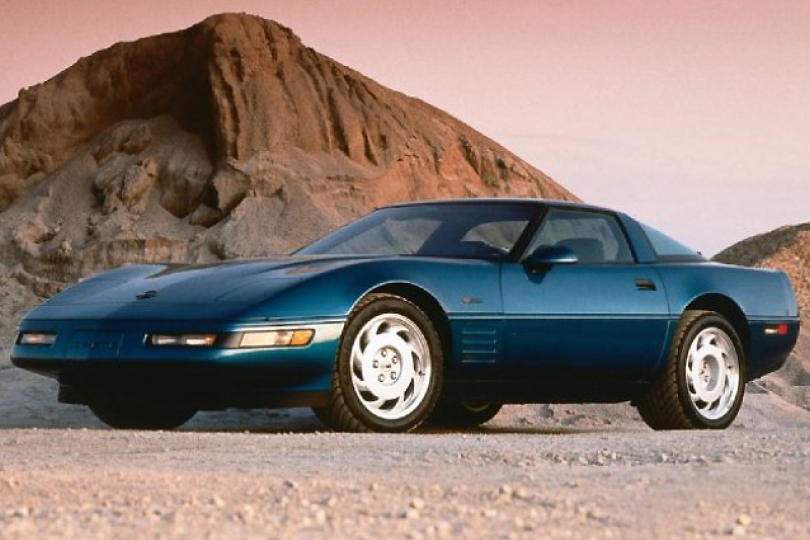
1984: Chief engineer Dave McLellan finally starts fresh with a new and smaller-perimeterframe, forged aluminum control arms, power rack-and-pinion steering, and aslippery exterior. The Stingray name goes into hibernation, where it slumbers next to—initially at least—powerful engine options. Introduced in March 1983, the C4 features205 horsepower, 290 lb-ft of torque, a one-piece removable roof panel, and digitalinstruments. Drag coefficient clocks in at a claimed 0.34, 24-percent more efficientthan that of its predecessor.Our road-test report by Brock Yates calls attention to the 0.90-g skidpad grip (thena C/D record), phenomenal braking, sub-seven-second 0–60 acceleration, and138-mph top speed. “This is a dead-serious sports car,” writes Yates. “It defers to thebizarre only with its video-game instrument panel, which features all manner of multicolored,liquid-crystal bar graphs, and digital displays in metric and English.” The baseprice is $21,800, and 51,547 1984 Vettes are produced.
1985: The second-year C4 debuts tuned port injection on the 5.7-liter V-8, boostinghorsepower to 230. 39,729 1985 coupes are built, 16 with the optional AM/FM CitizensBand radio.
1986: The convertible model returns after a 10-year absence, and serves as a pacecar for the Indy 500. All 7315 1986 convertibles are in fact “pace-car replicas,” with thedecals included for dealer or owner installation. Antilock brakes (ABS) are standard.1986 Corvette Convertible
1987: Horsepower climbs to 240 thanks to roller valve lifters. A new Z-52 suspensionoption is available on 1987 Corvettes for all-around ride and handling improvements.A Callaway twin-turbo setup is sold through select dealers as option “RPO B2K” for acool $19,995. The blown cars produce 345 hp and 465 lb-ft of torque.
1988: New dual-piston front brakes appear as standard kit, and 2050 35th AnniversaryEditions are produced. Chevy also builds 56 street-legal cars for the 1988 SCCACorvette Challenge race series.
1989: A jointly developed ZF/Chevrolet six-speed manual replaces the Doug Nash4+3 manual transmission. Chevy begins dropping ZR-1 hints. 26,412 1989 models areproduced.
1990: The Corvette ZR-1 debuts, sporting a 5.7-liter V8 capable of 375 hp. A Lotus/Chevrolet design, the engine boasts four camshafts and 32 valves, and is assembledby Mercury Marine in Stillwater, Oklahoma, before being shipped to Bowling Greenfor final assembly. The $27,016 ZR1 price nearly equals the base car’s $31,979 MSRP.3049 ZR-1s are produced. In the shadow of the ZR-1’s hubbub, a driver’s-side airbagbecomes standard, and ground is broken
1991: The first major restyle since 1984 adds ZR-1–style exterior bits to the 1991 Corvettecoupe and convertible. Finned power-steering coolers are introduced and theCorvette ZR-1 beats the 911 Turbo in a comparison test we published in April 1991Issue.
1992: A new 300-hp 5.7-liter small-block V-8 wearing the LT1 designation debuts inthe standard Corvette. Traction control becomes standard. The one-millionth Corvette—a white convertible with red interior, matching the first Corvette—rolls out ofthe Bowling Green facility on July 2, 1992.
1993: The term “STINGRAY” is finally registered as a trademark to General Motors,prompting rumors of a badge renaissance that wouldn’t come to fruition until the 2014model. Another special edition, this one featuring “Ruby Red” exterior paint, marks theCorvette’s 40th anniversary. ZR-1 power is increased to 405 horsepower.
1994: The National Corvette Museum opens in Bowling Green. Sequential Fuel Injectionprovides improved response, idle quality, driveability, and emissions. Twenty-fiveexamples are built as “official cars” for the inaugural Brickyard 400, some finding theirway into private hands.
1995: The ZR-1 concludes its five-year run with 6939 examples produced. A Corvettepaces the Indy 500 for the third time, and 527 purple-and-white special-editionconvertibles are produced. The big-brake package that previously came only with theZR-1 and Z07 packages is now standard.
1996: The C4’s final year includes Collector’s Edition and Grand Sport special models.The former features Sebring Silver paint, emblems, and an LT-1 engine. The GrandSport gets an LT4 engine, as well as blue metallic paint with a white stripe and red“hash marks” on the left-front fender. New for ’96, the LT4 350-cubic-inch small-blockis rated at 330 hp. The optional ($1695) Selective Real Time Damping system appearsfor the first time.

